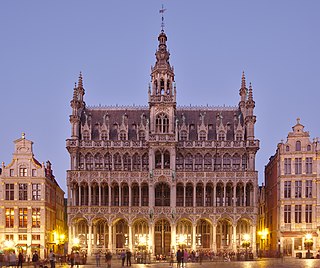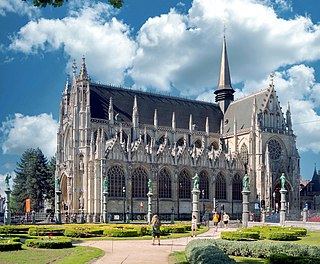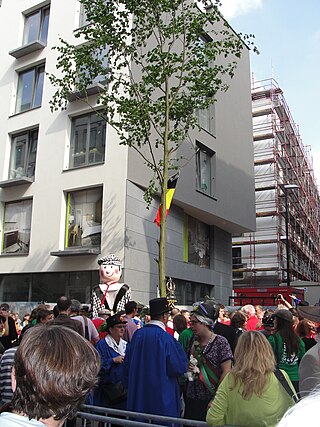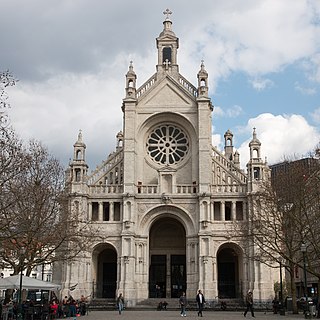
Manneken Pis is a landmark 55.5 cm (21.9 in) bronze fountain sculpture in central Brussels, Belgium, depicting a puer mingens; a naked little boy urinating into the fountain's basin. Though its existence is attested as early as the mid-15th century, Manneken Pis was redesigned by the Brabantine sculptor Jérôme Duquesnoy the Elder and put in place in 1619. Its stone niche in rocaille style dates from 1770. The statue has been repeatedly stolen or damaged throughout its history. Since 1965, a replica has been displayed, with the original stored in the Brussels City Museum.

Molenbeek-Saint-Jean or Sint-Jans-Molenbeek, often simply called Molenbeek, is one of the 19 municipalities of the Brussels-Capital Region, Belgium. Located in the western part of the region, it is bordered by the City of Brussels, from which it is separated by the Brussels–Charleroi Canal, as well as by the municipalities of Anderlecht, Berchem-Sainte-Agathe, Dilbeek, Jette, and Koekelberg. The Molenbeek brook, from which it takes its name, flows through the municipality. In common with all of Brussels' municipalities, it is legally bilingual (French–Dutch).

The Senne or Zenne is a small river that flows through Brussels, Belgium. Its source is in the village of Naast near the municipality of Soignies. It is an indirect tributary of the Scheldt, through the Dyle and the Rupel. It joins the Dyle at Zennegat in Battel, north of the municipality of Mechelen, only a few hundred metres before the Dyle itself joins the Rupel.

The City of Brussels is the largest municipality and historical centre of the Brussels-Capital Region, as well as the capital of the Flemish Region and Belgium. The City of Brussels is also the administrative centre of the European Union, as it hosts a number of principal EU institutions in its European Quarter.

Jeanneke Pis is a modern fountain sculpture in central Brussels, Belgium. It was commissioned by Denis-Adrien Debouvrie in 1985 and erected in 1987 as a counterpoint to the city's famous Manneken Pis. The 50-centimetre (20 in) bronze statue depicts a naked little girl with short pigtails, squatting and urinating on a blue-grey limestone base.
Brusselian is a Dutch dialect native to Brussels, Belgium. It is essentially a heavily-Francisized Brabantian Dutch dialect that incorporates a sprinkle of Spanish loanwords dating back to the rule of the Low Countries by the Habsburgs (1519–1713).

The Boulevard Anspach (French) or Anspachlaan (Dutch) is a central boulevard in Brussels, Belgium, connecting the Place de Brouckère/De Brouckèreplein to the Place Fontainas/Fontainasplein. It was created following the covering of the river Senne (1867–1871), and bears the name of Jules Anspach, a former mayor of the City of Brussels.

The Zinneke Parade is a biennial parade held in the City of Brussels, Belgium, since 2000. It is a cultural event organised by the Zinneke Association that brings together at each edition about 1,500 participants. A different theme is chosen for each parade.

Sculpture in Brussels is sculpture that has been created in Brussels, Belgium, since the Middle Ages to the present day. It began to shine in the second half of the 14th century with Claus Sluter's arrival in Brussels and the construction of Brussels' Town Hall. It continued without interruption and reached its momentum during 15th and 16th centuries. Until the end of the Ancien Régime, sculptors in Brussels were members of the Quatre Couronnés Guild of the Nation of St Nicholas and then the Royal Academy of Fine Arts.

The Brussels City Museum is a municipal museum on the Grand-Place/Grote Markt of Brussels, Belgium. Conceived in 1860 and inaugurated in 1887, it is dedicated to the history and folklore of the City of Brussels from its foundation into modern times, which it presents through paintings, sculptures, tapestries, engravings, photos and models, including a notable scale-representation of the town during the Middle Ages.

The Sablon or Zavel is a neighbourhood and hill in the historic upper town of Brussels, Belgium. At its heart are twin squares: the larger Grand Sablon or Grote Zavel square in the north-west and the smaller Petit Sablon or Kleine Zavel square and garden in the south-east, divided by the Church of Our Blessed Lady of the Sablon. This area is served by Brussels-Chapel railway station and Brussels-Central railway station, as well as the tram stop Petit Sablon/Kleine Zavel.

Tom Frantzen, is a Belgian sculptor, known for his street images.

L'Envol is a bronze statue of Belgian singer Jacques Brel, sculpted by Tom Frantzen. It was inaugurated on the Place de la Vieille Halle aux Blés/Oud Korenhuisplein in Brussels, Belgium, on 11 October 2017.

The Place de Brouckère or De Brouckèreplein (Dutch) is a major square in central Brussels, Belgium. It was created following the covering of the river Senne (1867–1871), replacing the Temple of the Augustinians, which was demolished in 1893. It is named in honour of Charles de Brouckère, a former mayor of the City of Brussels and professor at the Free University of Brussels, who played a great political role during the Belgian Revolution of 1830. The square measures approximately 50 by 350 metres and is nearly entirely paved.

The Place de la Bourse (French) or Beursplein (Dutch), meaning "Stock Exchange Square", is a major square in central Brussels, Belgium. It was created following the covering of the river Senne (1867–1871). The former Brussels Stock Exchange building, of which it takes its name, is located on this square. It is served by the premetro station Bourse/Beurse on lines 3 and 4.

The Meyboom plantation is the oldest tradition in Brussels, Belgium, attested since 1308. It is held every year on 9 August, the eve of St Lawrence's Day, and consists mainly in planting a beech at the intersection of the Rue des Sables/Zandstraat and the Rue du Marais/Broekstraat in the City of Brussels' Marais–Jacqmain District. It is accompanied by processions and various folk activities during the day.

The Place Anneessens (French) or Anneessensplein (Dutch) is a square in central Brussels, Belgium. It is named in honour of François Anneessens, dean of the Nation of St. Christopher, who was beheaded on the Grand-Place/Grote Markt during a period of uprisings within the Austrian Netherlands.

Saint Catherine's Church is a Roman Catholic parish church in Brussels, Belgium. It is dedicated to Saint Catherine.
The Bronze Zinneke is an award handed out by the cabinet of the Brussels Region to individuals, personalities, organisations, or companies that perform a role as informal ambassador of the Brussels Region or otherwise add to the positive image of the City and Region of Brussels.
















